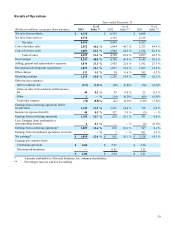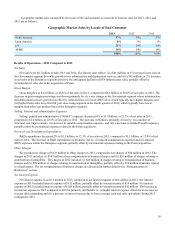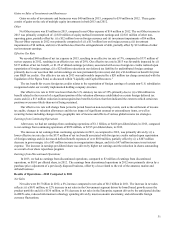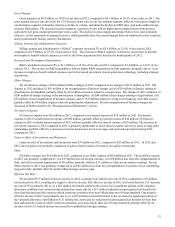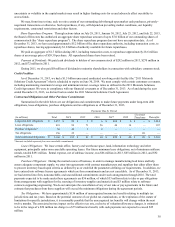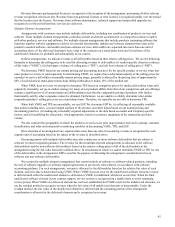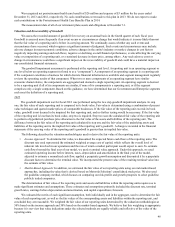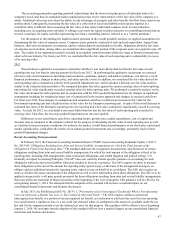Motorola 2013 Annual Report Download - page 41
Download and view the complete annual report
Please find page 41 of the 2013 Motorola annual report below. You can navigate through the pages in the report by either clicking on the pages listed below, or by using the keyword search tool below to find specific information within the annual report.
39
Commitments Under Other Long-Term Agreements: We have entered into certain long-term agreements to purchase
software, components, supplies and materials from suppliers which are not "take or pay" in nature. Most of the agreements
extend for periods of one to three years (three to five years for software). Generally, these agreements do not obligate us to
make any purchases, and many permit us to terminate the agreement with advance notice (usually ranging from 60 to 180
days). If we were to terminate these agreements, we generally would be liable for certain termination charges, typically based
on work performed and supplier on-hand inventory and raw materials attributable to canceled orders. Our liability would only
arise in the event we terminate the agreements for reasons other than “cause.”
We outsource certain corporate functions, such as benefit administration and information technology-related services.
These contracts are expected to expire in 2017. Our remaining payments under these contracts are approximately $485 million
over the remaining life of the contracts; however, these contracts can be terminated. Termination would result in a penalty
substantially less than the remaining annual contract payments. We would also be required to find another source for these
services, including the possibility of performing them in-house.
As is customary in bidding for and completing certain projects and pursuant to a practice we have followed for many
years, we have a number of performance/bid bonds, standby letters of credit and surety bonds outstanding (collectively, referred
to as “Performance Bonds”), primarily relating to projects of the Government segment. These Performance Bonds normally
have maturities of multiple years and are standard in the industry as a way to give customers a convenient mechanism to seek
resolution if a contractor does not satisfy certain requirements under a contract. Typically, a customer can draw on the
Performance Bond only if we do not fulfill all terms of a project contract. If such an occasion occurred, we would be obligated
to reimburse the institution that issued the Performance Bond for the amounts paid. In our long history, it has been rare for us to
have a Performance Bond drawn upon. At December 31, 2013, outstanding Performance Bonds totaled approximately $809
million, compared to $891 million at December 31, 2012. Any future disruptions, uncertainty, or volatility in bank, insurance or
capital markets, or a change in our credit ratings could adversely affect our ability to obtain Performance Bonds and may result
in higher funding costs.
Off-Balance Sheet Arrangements: Under the definition contained in Item 303(a)(4)(ii) of Regulation S-K, we do not
have any off-balance sheet arrangements.
Long-term Customer Financing Commitments
Outstanding Commitments: Certain purchasers of our products and services may request that we provide long-term
financing (defined as financing with a term of greater than one year) in connection with the sale of equipment. These requests
may include all or a portion of the purchase price of the products and services. Our obligation to provide long-term financing
may be conditioned on the issuance of a letter of credit in favor of us by a reputable bank to support the purchaser's credit or a
pre-existing commitment from a reputable bank to purchase the long-term receivables from us. We had outstanding
commitments to provide long-term financing to third-parties totaling $120 million at December 31, 2013, compared to $84
million at December 31, 2012.
Outstanding Long-Term Receivables: We had net non-current long-term receivables of $6 million at December 31, 2013,
compared to net non-current long-term receivables of $60 million (net of allowances for losses of $10 million) at December 31,
2012. These long-term receivables are generally interest bearing, with interest rates ranging from 2% to 13%.
Sales of Receivables
From time to time, we sell accounts receivable and long-term receivables to third-parties under one-time arrangements
while others have been sold to third-parties under committed facilities that involve contractual commitments. We may or may
not retain the obligation to service the sold accounts receivable and long-term receivables. We had no significant committed
facilities for the sale of long-term receivables at December 31, 2013 or at December 31, 2012.
The following table summarizes the proceeds received from sales of accounts receivable and long-term receivables for
the years ended December 31, 2013, 2012, and 2011:
Years ended December 31 2013 2012 2011
Cumulative annual proceeds received from sales:
Accounts receivable sales proceeds $ 14 $ 12 $ 8
Long-term receivables sales proceeds 151 178 224
Total proceeds from receivable sales $ 165 $ 190 $ 232
At December 31, 2013, the Company had retained servicing obligations for $434 million of long-term receivables,
compared to $375 million of long-term receivables at December 31, 2012. Servicing obligations are limited to collection
activities of the sales of accounts receivables and long-term receivables.


